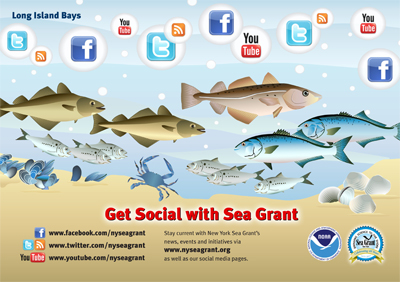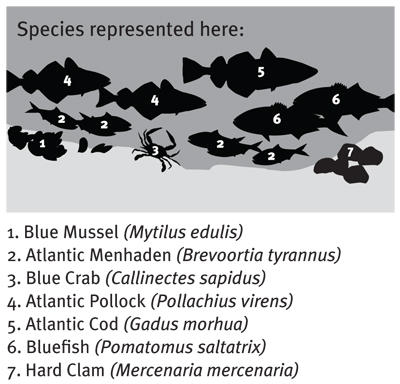
The concept behind this set of postcards - one featuring species commonly found in Long Island bays and another set in New York's Great Lakes ecosystem - is to generate interest in New York Sea Grant's news, events and initiatives via this Web site, nyseagrant.org, as well as through our program's social media platforms - Facebook, Twitter, RSS news feeds, and YouTube. Each postcard also serves as a companion piece to its respective ecosystem poster for the Long Island Bays and in New York's Great Lakes.
And now that the various fish in both scenes have discovered how easy it is to "Get Social with Sea Grant," they're sure to share the newly-learned news bites with their respective schools of fish, bolstering the idea of a "multiplier effect" method in education.
So, like the fish in Long Island's bays and New York's Great Lakes ecosystem, swim around our site and social media platforms and learn more about New York Sea Grant.
New York Sea Grant (NYSG) is a statewide network of integrated research, education, and extension services promoting the coastal economic vitality, environmental sustainability and citizen awareness about the State’s marine and Great Lakes resources. NYSG, one of 32 university-based programs under the National Sea Grant College Program of the National Oceanic and Atmospheric Administration (NOAA), is a cooperative program of the State University of New York and Cornell University.

More about the species featured in this postcard:
Blue Mussel (Mytilus edulis)
The blue mussel is a bivalve shellfish with a smooth elongated blue to blue-black shell. Commonly ranging in size from two to over four inches in length, blue mussels are most abundant from the Canadian maritime provinces through New York and New Jersey and are found as far south as North Carolina. Blue mussels live along the shore in tidal and subtidal areas. They anchor themselves to rocks, pilings, and other mussels with their "byssal threads" commonly known as the mussel's "beard". This anchoring is necessary to allow mussels to remain fixed in one location in tidal areas subjected to the force of wind and waves.
Atlantic menhaden (Brevoortia tyrannus)
The Atlantic menhaden is a silvery, highly compressed fish in the herring family. A filter feeder, it lives on plankton caught in midwater. Adult fish can filter up to four gallons of water a minute; and they play an important role in clarifying ocean water. Menhaden historically occurred in large numbers in the North Atlantic, ranging from Nova Scotia, Canada to central Florida, USA, although their presence in northern waters has diminished over the last century. They swim in large schools, some reportedly up to 40 miles long. As a result of their abundance, they are important prey for a wide range of predators including bluefish, striped bass, cod, haddock, halibut, mackerel, swordfish, and tuna.
Blue Crab (Callinectes sapidus)
Blue crabs are crustaceans that have a hard shell and 10 legs. They live in shallow near shore waters during the warm months of the year. Like all crustaceans, the blue crab grows by a process called molting, in which it sheds its shell, absorbs water to expand the new shell before it hardens leaving room for the crab to grow. During the 9 -12 hours after the crab has shed its old hard shell, its new shell is soft and papery. The Latin name for blue crab is Callinectes which means "beautiful swimmer" and sapidus which means "savory". The blue crab is a true "swimming crab." It uses its back leg to swim through the water, which is why it can move so quickly.
Atlantic Pollock (Pollachius virens)
Atlantic pollock are brownish green on the back and paler on the belly and can be distinguished from cod by their greenish hue. They area found on both sides of the North Atlantic Ocean, but there is a different species, Pollachius pollachius (commonly known as saithe) in the Eastern Atlantic. In the Northwest Atlantic, pollock is most abundant on the western Scotian Shelf and in the Gulf of Maine. Atlantic pollock is an important, but not a dominant fish-eater in the ecosystem. They do not typically consume a significant amount of most prey species except for shrimp and sometimes herring.
Atlantic Cod (Gadus morhua)
Cod is an ocean species that can be found from the intertidal zone to the deep ocean waters at the edge of the continental shelf. They are one of the most well known and familiar fish species in the Northeast, having played an important role in the history and economic prosperity of the region since Colonial times. They are caught from the Arctic Circle to as far south as Virginia and Maryland on the American side of the Atlantic ocean. Cod live near the ocean bottom, and are generally harvested by offshore fishermen across the Northeast with trawl nets from offshore fishing grounds. In New York, cod is primarily harvested by commercial fishermen based in Montauk, Shinnecock, Greenport and other ports along Long Island's south shore.
Bluefish (Pomatomus saltatrix) (related fact sheet: pdf)
Bluefish (also known as snapper or blues) have sharp teeth to catch their fish prey, including other bluefish. They have good vision and are fast swimmers. They are schooling pelagic fish, meaning they inhabit open ocean waters rather than coastal areas. Bluefish prefer the middle of the water column or stay close to the surface. Only large predators such as sharks, tunas, and swordfish can catch adult bluefish.
Hard Clam (Mercenaria mercenaria) (related NYSG Web site: click here)
The hard clam is one of several different species or types of clam found in New York's marine waters. Though you may not recognize the term "hard clam," you probably know its market names: chowders are the largest, cherries or cherrystones are medium in size and littlenecks are the smallest hard clams. Littleneck, also referred to as necks, are the most commercially valuable of the three, traditionally consumed cooked or raw on the half shell. Other clams harvested in New York waters are surf clams, ocean quahogs and softshell clams or steamers.
The hard clam (or northern quahog) lives in shallow coastal bay waters in areas with a soft sandy bottom. The clam burrows into the bottom substrate leaving only the siphon exposed to pump water containing food and oxygen and to dispose of waste. Scientists estimate that hard clams reproduce in 1 to 2 years, and that the average number of years required to reach a commercial size is about 3 years in the New York, Rhode Island, Massachusetts area. Actual growth rates are dependent on a number of factors like water temperature, salinity, and dissolved oxygen, the quality and quantity of available food, and other factors.
A sample of some related NYSG articles and fact sheets include:
- Color Your Catch (pdf)
Kids learn about some Long Island fish species - including bluefish, summer flounder and striped bass - while they color away and draw lines to their favorite catch
- IFISHNY Lesson Plans (click here)
Educational materials for teachers: lesson plans, background info, handouts and supplemental activites. THis info, which can be used in formal or informal classroom settigns, is aligned with NYS Education Learning Standards.
- IFISHNY Games (click here)
Download fish-themed matching, word finds, word jumbles and mazes.
Hard Clam research
- Coastlines, Summer '10: Jellies with an Appetite for Clams (click here)
- Coastlines, Spring '09: New Report Synthesizes Hard Clam Research (click here)
- Coastlines, Fall '07: Taking the 'X' out of QPX Disease (click here)
- Coastlines, Fall '04: New Insights About South Shore Estuary Hard Clams (pdf)
- Coastlines, Summer '04: Funding Breakthrough Research (incl. new hard clam research) (pdf)
- Coastlines, Spring '04: Unknown Parasite Is Hard on Clams (QPX Disease) (pdf)
- Coastlines, Spring '02: Focus on Research (incl.new hard clam research) (pdf)
- Coastlines, Summer '01: New Initiatives: Shoring up Support for Hard Clams (pdf)
- Coastlines, Spring/Summer '99: ... Working Hard to Restore Clams (pdf)
Lobster research/extension
- News, September 2010: What’s Eating Those Lobsters?: An Understanding of Shell Disease in American Lobsters Offered at Sea Grant Symposium (click here)
- Coastlines, Winter '06: Lobster Research Findings Appear in Shellfish Journal (pdf)
- Coastlines, Spring '05: Results of LIS Lobster Research are Presented (4th symposium) (pdf)
- Coastlines, Spring '04: A Winning Team for Lobster Outreach (pdf)
- Coastlines, Spring '02: Researching Lobster Health in LIS (2nd symposium) (pdf)
- Coastlines, Summer '01: New Initiatives: Lobster Mortalities and Shell Disease (pdf)
- Coastlines, Summer '00: What's Happening to LIS Lobsters? (1st symposium) (pdf)
For additional information about the species represented here, check out the following Web resources: